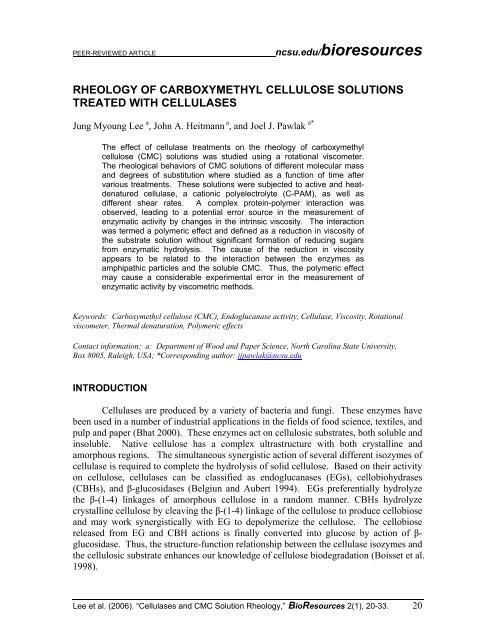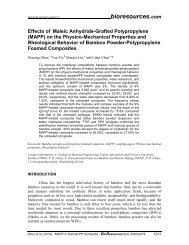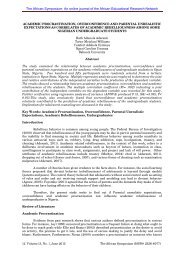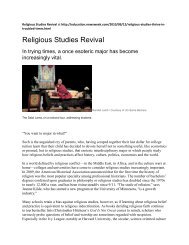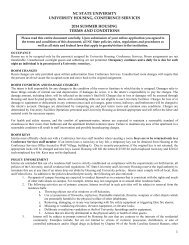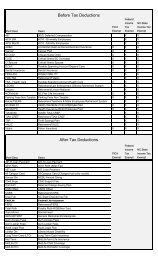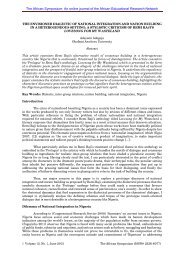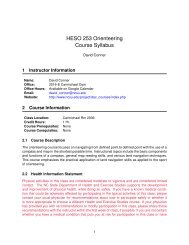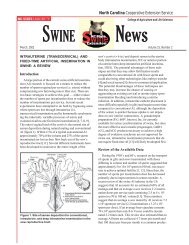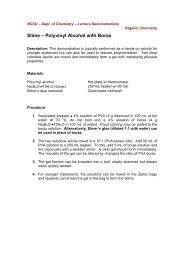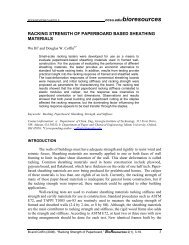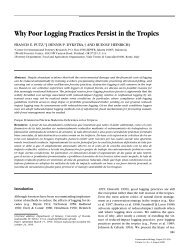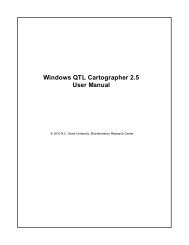Rheology of carboxymethyl cellulose solutions - North Carolina ...
Rheology of carboxymethyl cellulose solutions - North Carolina ...
Rheology of carboxymethyl cellulose solutions - North Carolina ...
You also want an ePaper? Increase the reach of your titles
YUMPU automatically turns print PDFs into web optimized ePapers that Google loves.
PEER-REVIEWED ARTICLE ncsu.edu/bioresources<br />
RHEOLOGY OF CARBOXYMETHYL CELLULOSE SOLUTIONS<br />
TREATED WITH CELLULASES<br />
Jung Myoung Lee a , John A. Heitmann a , and Joel J. Pawlak a*<br />
The effect <strong>of</strong> cellulase treatments on the rheology <strong>of</strong> <strong>carboxymethyl</strong><br />
<strong>cellulose</strong> (CMC) <strong>solutions</strong> was studied using a rotational viscometer.<br />
The rheological behaviors <strong>of</strong> CMC <strong>solutions</strong> <strong>of</strong> different molecular mass<br />
and degrees <strong>of</strong> substitution where studied as a function <strong>of</strong> time after<br />
various treatments. These <strong>solutions</strong> were subjected to active and heatdenatured<br />
cellulase, a cationic polyelectrolyte (C-PAM), as well as<br />
different shear rates. A complex protein-polymer interaction was<br />
observed, leading to a potential error source in the measurement <strong>of</strong><br />
enzymatic activity by changes in the intrinsic viscosity. The interaction<br />
was termed a polymeric effect and defined as a reduction in viscosity <strong>of</strong><br />
the substrate solution without significant formation <strong>of</strong> reducing sugars<br />
from enzymatic hydrolysis. The cause <strong>of</strong> the reduction in viscosity<br />
appears to be related to the interaction between the enzymes as<br />
amphipathic particles and the soluble CMC. Thus, the polymeric effect<br />
may cause a considerable experimental error in the measurement <strong>of</strong><br />
enzymatic activity by viscometric methods.<br />
Keywords: Carboxymethyl <strong>cellulose</strong> (CMC), Endoglucanase activity, Cellulase, Viscosity, Rotational<br />
viscometer, Thermal denaturation, Polymeric effects<br />
Contact information: a: Department <strong>of</strong> Wood and Paper Science, <strong>North</strong> <strong>Carolina</strong> State University,<br />
Box 8005, Raleigh, USA; *Corresponding author: jjpawlak@ncsu.edu<br />
INTRODUCTION<br />
Cellulases are produced by a variety <strong>of</strong> bacteria and fungi. These enzymes have<br />
been used in a number <strong>of</strong> industrial applications in the fields <strong>of</strong> food science, textiles, and<br />
pulp and paper (Bhat 2000). These enzymes act on cellulosic substrates, both soluble and<br />
insoluble. Native <strong>cellulose</strong> has a complex ultrastructure with both crystalline and<br />
amorphous regions. The simultaneous synergistic action <strong>of</strong> several different isozymes <strong>of</strong><br />
cellulase is required to complete the hydrolysis <strong>of</strong> solid <strong>cellulose</strong>. Based on their activity<br />
on <strong>cellulose</strong>, cellulases can be classified as endoglucanases (EGs), cellobiohydrases<br />
(CBHs), and β-glucosidases (Belgiun and Aubert 1994). EGs preferentially hydrolyze<br />
the β-(1-4) linkages <strong>of</strong> amorphous <strong>cellulose</strong> in a random manner. CBHs hydrolyze<br />
crystalline <strong>cellulose</strong> by cleaving the β-(1-4) linkage <strong>of</strong> the <strong>cellulose</strong> to produce cellobiose<br />
and may work synergistically with EG to depolymerize the <strong>cellulose</strong>. The cellobiose<br />
released from EG and CBH actions is finally converted into glucose by action <strong>of</strong> βglucosidase.<br />
Thus, the structure-function relationship between the cellulase isozymes and<br />
the cellulosic substrate enhances our knowledge <strong>of</strong> <strong>cellulose</strong> biodegradation (Boisset et al.<br />
1998).<br />
Lee et al. (2006). “Cellulases and CMC Solution <strong>Rheology</strong>,” BioResources 2(1), 20-33. 20
PEER-REVIEWED ARTICLE ncsu.edu/bioresources<br />
Enzyme activity is measured by the production <strong>of</strong> sugar reducing end group,<br />
which is taken to be an indication <strong>of</strong> cleavage <strong>of</strong> the <strong>cellulose</strong> molecules. It is also an<br />
indication <strong>of</strong> the efficiency <strong>of</strong> the cellulase hydrolyzing reaction. The determination <strong>of</strong><br />
cellulase activity is a complicated process, because the hydrolysis <strong>of</strong> insoluble <strong>cellulose</strong><br />
may not be linear with enzyme dosage and/or reaction time. Thus, the dosage <strong>of</strong> enzyme<br />
and the point in the reaction at which the activity is measured is critical. For such reasons,<br />
enzymatic activity should be carefully determined. Several standard substrates are<br />
available for the determination <strong>of</strong> cellulase activity in terms <strong>of</strong> the overall and EG activity<br />
(Ghose 1987). Filter papers have been used as a standard substrate to measure the total<br />
cellulase activity (Wu et al. 2006). The filter paper activity, termed as FPase, expressed<br />
the summations <strong>of</strong> the simultaneous synergistic action <strong>of</strong> EGs, CBHs, and β-glucosidase<br />
in a cellulase preparation. Soluble <strong>cellulose</strong> derivatives, such as <strong>carboxymethyl</strong> <strong>cellulose</strong><br />
(CMC) and hydroxyethyl <strong>cellulose</strong> (HEC), may be used as substrates for determining EG<br />
activity. These substrates are rather specific to EG activity, since CBHs are not generally<br />
able to degrade substituted <strong>cellulose</strong> (Rouvinen et al. 1990). The hydrolysis rate <strong>of</strong> EG<br />
was conventionally determined by reduction <strong>of</strong> viscosity or by increase <strong>of</strong> reducing sugar<br />
end groups <strong>of</strong> the <strong>cellulose</strong> derivatives (Sharrock 1988; Mullings 1985). Recently, based<br />
on adsorption behaviors <strong>of</strong> free and bound enzymes on microcrystalline <strong>cellulose</strong> (MCC),<br />
a new measurement <strong>of</strong> EG activity has been introduced (Zhou et al. 2004). Among these<br />
methods, monitoring the reduction in CMC solution viscosity is considered to be the most<br />
accurate method to detect EG activity (Almin and Eriksson 1967; Valsenko et al. 1998).<br />
However, the viscometric method for measuring activity is not commonly used due to its<br />
laborious and discontinuous nature. For this reason, the colorimetric measurement <strong>of</strong><br />
reducing sugars has been routinely used for measurement <strong>of</strong> EG activity.<br />
Various types <strong>of</strong> automated viscometers are available to measure the rheological<br />
changes <strong>of</strong> a polymer solution. Viscosity is a fundamental rheological parameter that<br />
characterizes the resistance <strong>of</strong> the fluid to flow. The viscosity <strong>of</strong> a polymer solution is<br />
related to the polymer concentration, the extent <strong>of</strong> polymer-solvent interaction, and the<br />
polymer structure such as molecular weight, shape, molecular flexibility, and molecular<br />
conformation. Under appropriate experimental conditions, it is functionally related to the<br />
molecular weight (Browning 1967). However, a more complete understanding <strong>of</strong> the<br />
rheological changes in a cellulase-polymer solution is required to accurately monitor<br />
<strong>cellulose</strong> hydrolysis by viscosity measurements.<br />
Like all proteins, enzymes are basically made up <strong>of</strong> amino acids linked by peptide<br />
bonds between the carboxyl groups <strong>of</strong> one amino acid and the amino group <strong>of</strong> the next<br />
amino acid. The hydrophobic and hydrophilic nature <strong>of</strong> amino acids <strong>of</strong>ten makes the<br />
surface <strong>of</strong> enzymes have an amphipathic interfacial structure, i.e. proteins tend to adsorb<br />
at interfaces as a surface-active polymer (Britt et al. 2003). Moreover, CMC is a<br />
semiflexible anionic polymer (Hoogendam et al. 1998). The adsorption <strong>of</strong> enzymes<br />
(protein) on the CMC leads to a change <strong>of</strong> the polymer behavior. Of particular interest is<br />
the effect <strong>of</strong> enzyme absorption on the rheology <strong>of</strong> a cellulase-CMC solution. Mixtures<br />
<strong>of</strong> proteins (enzymes) and polymers in aqueous dispersion are <strong>of</strong>ten accompanied by<br />
either segregative or associative phase separation (Doublier et al. 2000). Thus, physical<br />
and chemical parameters <strong>of</strong> the proteins (enzymes) and substrate and solution<br />
characteristics such as solution pH, ionic strength, concentration and protein/polymer<br />
Lee et al. (2006). “Cellulases and CMC Solution <strong>Rheology</strong>,” BioResources 2(1), 20-33. 21
PEER-REVIEWED ARTICLE ncsu.edu/bioresources<br />
ratio should be considered. Moreover, processing variables such as temperature, shear<br />
rate, and time also strongly influence the rheological behavior <strong>of</strong> the complexes. For<br />
example, changes in functional properties due to soluble complexes between a globular<br />
protein (BSA) and a polysaccharide (CMC) have been reported (Tuiner et al. 2000;<br />
Renard et al. 1997). The protein was adsorbed onto the CMC segments in the dilute<br />
regime or entrapped in the polymer network in the semi-dilute region. After thermal<br />
treatment <strong>of</strong> the soluble complexes, a considerable change in the visco-elastic properties<br />
<strong>of</strong> the network was observed (Renard et al. 1998).<br />
When a cellulase is added to a soluble <strong>cellulose</strong> derivative (e.g. CMC), one might<br />
expect that the rheological behavior <strong>of</strong> the mixture will change considerably as a function<br />
<strong>of</strong> reaction time. The change in the viscosity may be due to the cellulase ad- and desorbing<br />
or entrapping the substrate. The configuration and conformation <strong>of</strong> the substrate<br />
molecules will then be changed. These interactions between cellulases and substrates<br />
may be expected to result in considerable changes in the solution viscosity. Thus,<br />
significant changes in the solution viscosity may result without any enzymatic hydrolysis<br />
taking place. It should also be noted that reductions <strong>of</strong> enzymatic activity and its binding<br />
ability are expected when enzymes are continuously subjected to shear or exposed to an<br />
air-liquid interface during mixing and agitation processes (Kaya et al. 1994; Kim et al.<br />
1982).<br />
The study reported herein investigates the rheological behavior <strong>of</strong> CMC <strong>solutions</strong><br />
during enzyme hydrolysis and the influence <strong>of</strong> enzymes on CMC <strong>solutions</strong> without<br />
hydrolysis. The ability <strong>of</strong> enzymes to reduce CMC solution viscosity without hydrolysis<br />
was investigated in two manners. First a heat-denatured enzyme was applied to the CMC<br />
solution. Second, a high degree <strong>of</strong> substitution CMC was used. This CMC could not be<br />
degraded by the enzymes. In addition, the effects <strong>of</strong> shear rate and contact time were<br />
evaluated during the cellulase-polymer interaction.<br />
EXPERIMENTAL<br />
Materials<br />
A commercial enzyme preparation supplied by Dyadic International (Fibrezyme L,<br />
Florida, USA) was used in this study. The cellulase preparation was fractionated by<br />
using a 10 kD cut-<strong>of</strong>f filter (Amicon, USA) and then used as an active cellulase<br />
preparation. In order to make a heat-denatured cellulase preparation, a 10 g l -1 solution <strong>of</strong><br />
the active cellulase preparation was transferred to a glass tube and covered. The tube was<br />
then placed in a boiling water bath for 2 hours with vigorous agitation. After the boiling,<br />
the suspension was homogenized for 15 minutes with an ultrasonic homogenizer (Omni<br />
Ruptor 250, Omni international Inc, USA) in order to make a well dispersed heatdenatured<br />
cellulase suspension. The active and heat-denatured cellulase suspensions<br />
were refrigerated during storage.<br />
Five commercial <strong>carboxymethyl</strong> <strong>cellulose</strong>s (CMCs) in the sodium salt form <strong>of</strong><br />
different average degrees <strong>of</strong> polymerization (DP) and degrees <strong>of</strong> substitution (DS) were<br />
obtained from Aqualon Hercules Inc. (Wilmington, Delaware, USA): 7L (0.7 DS and 400<br />
DP), 7M (0.7 DS and 1,100 DP), 7H (0.7 DS and 3,200 DP), 9M8 (0.9 and 800 DP), and<br />
Lee et al. (2006). “Cellulases and CMC Solution <strong>Rheology</strong>,” BioResources 2(1), 20-33. 22
PEER-REVIEWED ARTICLE ncsu.edu/bioresources<br />
12M8 (1.2 DS and 800 DP). The letters L, M, and H correspond to low, medium, and<br />
high molecular mass. According to the manufacturer, the typical molecular mass values<br />
corresponding to these categories are 90,000, 250,000, and 700,000 Daltons. A cationic<br />
polyacrylamide (C-PAM) (Percol® 175, from Ciba Specialty Chemicals) was also used.<br />
Its molecular mass is approximately 5,000,000 Daltons.<br />
Methods<br />
Preparation <strong>of</strong> CMC <strong>solutions</strong><br />
An appropriate amount <strong>of</strong> the CMCs was slowly added into a sodium acetate<br />
buffer (50 mM, pH 4.7) to make 1.0 % and 1.4 % concentrations <strong>of</strong> CMC suspensions<br />
under vigorous agitation. After completing the addition, the suspensions were transferred<br />
to a blender and vigorously mixed for one minute at room temperature. The blended<br />
suspension was stirred for one hour, while heating to 80 °C. In order to make<br />
homogenous CMC <strong>solutions</strong>, the suspension was then filtered through a sintered glass<br />
(coarse) funnel into a vacuum filtering flask. The suspension was then agitated for one<br />
hour at room temperature under the vacuum to remove entrapped air bubbles. The CMC<br />
<strong>solutions</strong> were stored at 4 °C and used within one week. After one week, fresh CMC<br />
<strong>solutions</strong> were again prepared.<br />
Enzymatic hydrolysis and its viscosity measurement<br />
Enzymatic hydrolysis <strong>of</strong> CMC <strong>solutions</strong> was performed using a Brookfield<br />
rotational viscometer with a UL adaptor (Brookfield DV-II+2, USA). 20 ml <strong>of</strong> each<br />
CMC suspension was preheated at 50 °C in a water bath before being transferred to the<br />
UL adaptor, which was controlled to 50 °C. One ml <strong>of</strong> each cellulase preparation was<br />
added to the CMC suspension to start the enzymatic reaction. The apparent viscosity <strong>of</strong><br />
CMCs was collected every one minute with an automated program (Rheocalc®,<br />
Brookfield instrument, USA). The viscometer used a rotational speed <strong>of</strong> 10 rpm except<br />
during the shear rate dependence experiments. During this set <strong>of</strong> experiments the shear<br />
rates were varied in the range <strong>of</strong> 1 to 32 rpm.<br />
Reducing sugar measurement<br />
The reaction products <strong>of</strong> enzymatic hydrolysis were transferred into a test tube as<br />
quickly as possible to determine the concentration <strong>of</strong> reducing sugar end-groups in the<br />
sample. The amounts <strong>of</strong> reducing sugar end groups formed by cellulase action were<br />
determined by the dinitrosalicylic acid (DNS) method (Miller et al. 1960) using glucose<br />
to generate a standard curve.<br />
RESULTS AND DISCUSSION<br />
Polymeric and Enzymatic Effects <strong>of</strong> Cellulase<br />
Figure 1 shows the change <strong>of</strong> the apparent viscosity as a function <strong>of</strong> time with the<br />
addition <strong>of</strong> active and heat-denatured enzymes. It should be noted that the zero time<br />
viscosity <strong>of</strong> the CMC <strong>solutions</strong> are indicative <strong>of</strong> the pure CMC solution viscosity. Also,<br />
Lee et al. (2006). “Cellulases and CMC Solution <strong>Rheology</strong>,” BioResources 2(1), 20-33. 23
PEER-REVIEWED ARTICLE ncsu.edu/bioresources<br />
at the enzyme concentration used, there was no detectable difference between water and<br />
the enzyme solution viscosity. It is clear from this figure that both the active and the<br />
heat-denatured enzyme reduce the viscosity <strong>of</strong> the CMC solution as a function <strong>of</strong> contact<br />
time. This seems to imply that the heat-denatured enzyme preparation retains a portion<br />
<strong>of</strong> its activity, although the preparation was brought to boiling for 2 hours.<br />
Viscosity (cP)<br />
20<br />
15<br />
10<br />
5<br />
0<br />
Viscosity with active cellulase<br />
Viscosity with heat-denatured cellulase<br />
Reducing sugar with active cellulase<br />
Reducing sugar with heat-denatured cellulase<br />
0 20 40 60 80 100<br />
Time (min.)<br />
Fig. 1. Changes in apparent viscosity (50 °C and 10 rpm) and reducing sugar <strong>of</strong> 7 M CMC (1.0 %<br />
conc.) treated with active and heat-denatured cellulase as a function <strong>of</strong> time.<br />
In order to examine whether the change in viscosity <strong>of</strong> the solution with the heatdenatured<br />
enzyme is from its residual activity, the production <strong>of</strong> reducing end groups in<br />
the hydrolysates from the active and heat-denatured cellulases were analyzed by the DNS<br />
method. The concentration <strong>of</strong> reducing sugar (glucose equivalent) liberated from the<br />
CMC can be used as a measure <strong>of</strong> hydrolytic efficiency <strong>of</strong> the active and heat-denatured<br />
cellulase preparations. The active cellulase depolymerized the substrate as a function <strong>of</strong><br />
reaction time, leading to increased formation <strong>of</strong> the reducing sugar, whereas the heatdenatured<br />
preparation showed no significant change in the reducing sugar. It appears<br />
likely that the thermal denaturation <strong>of</strong> cellulases (Baker et al. 1992; Andreaus et al. 1999)<br />
and proteins (Kelly et al. 1994; Shimada and Cheftel 1989) caused partial unfolding <strong>of</strong><br />
the proteins due to the disruption <strong>of</strong> the hydrogen bonds responsible for the threedimensional<br />
structure. This may expose highly reactive groups buried inside the protein<br />
structure to the solution. This may lead to increased sites available for the CMC to<br />
interact with the de-natured enzyme causing conformational changes <strong>of</strong> the substrate<br />
(Kelly et al. 1994). Based on this observation, the results in Figure 1 imply that the heat-<br />
Lee et al. (2006). “Cellulases and CMC Solution <strong>Rheology</strong>,” BioResources 2(1), 20-33. 24<br />
5<br />
4<br />
3<br />
2<br />
1<br />
0<br />
Reducing sugar (mg/ml)
PEER-REVIEWED ARTICLE ncsu.edu/bioresources<br />
denatured enzyme alters the conformation <strong>of</strong> the CMC and thus changes the viscosity <strong>of</strong><br />
the solution. The change in the viscosity due to the amphipathic nature <strong>of</strong> the enzyme<br />
has been the termed the polymeric effect in this study.<br />
Effect <strong>of</strong> Cationic Polymer<br />
A decrease in the viscosity <strong>of</strong> a CMC solution was also observed when a cationic<br />
polymer was added to the solution, cf. Figure 2. In this figure, one can see a decrease in<br />
the CMC solution viscosity over time with cationic polymer and heat-denatured enzyme<br />
addition. After 90 minutes <strong>of</strong> elapsed time the <strong>solutions</strong> were left in the viscometer for<br />
500 minutes without shearing, and then the viscosities <strong>of</strong> the <strong>solutions</strong> were again<br />
measured. The viscosity with heat-denatured enzyme decreased slightly (3 cPs), whereas<br />
the viscosity with the cationic polymer increased over 500 cPs. This indicates that the<br />
cationic polyelectrolyte (C-PAM) interacts with the anionic polymer (CMC) as a function<br />
<strong>of</strong> time, forming a complex, and thus leading to an increase in the viscosity. This<br />
increase, in the absence <strong>of</strong> stirring, may be attributed to the high degree <strong>of</strong> polymerization<br />
<strong>of</strong> the C-PAM.<br />
Viscosity (cP)<br />
50<br />
45<br />
40<br />
35<br />
30<br />
Viscosity (cP)<br />
after 500 min. elapsed<br />
Heat-denatured cellulase<br />
C-PAM<br />
0 20 40 60 80 100<br />
Time (min.)<br />
Fig. 2. Changes in apparent viscosity <strong>of</strong> 7 M CMC (1.4 % conc.) treated with the heat-denatured<br />
enzyme or C-PAM (0.1 % conc.) at 50 °C and 10 rpm as a function <strong>of</strong> time. The inserted plot<br />
represents the apparent viscosity <strong>of</strong> the CMC after 500 minutes elapsed.<br />
Effect <strong>of</strong> CMCs with Different DS<br />
The polymeric effect, which reduces the CMC viscosity without the creation <strong>of</strong><br />
reducing end groups, can also be observed using CMC with different degrees <strong>of</strong><br />
substitution. Figure 3 shows the viscosity <strong>of</strong> CMC with different degrees <strong>of</strong> substitution<br />
Lee et al. (2006). “Cellulases and CMC Solution <strong>Rheology</strong>,” BioResources 2(1), 20-33. 25<br />
600<br />
400<br />
200<br />
0<br />
500
PEER-REVIEWED ARTICLE ncsu.edu/bioresources<br />
as a function <strong>of</strong> enzyme contact time. Also shown in this figure is the concentration <strong>of</strong><br />
reducing end groups as a function <strong>of</strong> time. It is known that the susceptibility <strong>of</strong> CMC to<br />
enzyme hydrolysis is dependent on degree <strong>of</strong> substitution (DS) <strong>of</strong> the CMC. When the<br />
DS <strong>of</strong> CMC reaches an average <strong>of</strong> one substitution per glucose unit, steric factors<br />
strongly retard the enzyme activity (Focher et al. 1991). Thus the International Union <strong>of</strong><br />
Pure and Applied Chemistry (IUPAC) recommended CMC having a DS <strong>of</strong> 0.7 as a<br />
substrate for measuring cellulase activity (Ghose 1987). The inhibition <strong>of</strong> enzyme<br />
activity at high DS is shown again here by the lack <strong>of</strong> increase in reducing end group<br />
concentration with increased reaction time for the 1.2 DS CMC. However, it is noted that<br />
the viscosities <strong>of</strong> CMC decreased in a similar manner for all degrees <strong>of</strong> substitution,<br />
regardless <strong>of</strong> the change in the reducing end groups. This again indicates that a<br />
“polymeric effect” plays an important role in determining the viscosity <strong>of</strong> the CMC<br />
solution independent <strong>of</strong> hydrolytic activity.<br />
Viscosity (cP)<br />
80<br />
60<br />
40<br />
20<br />
0<br />
0.7 DS<br />
0.9 DS<br />
1.2 DS<br />
0<br />
Reducing sugar (mg/ml)<br />
0.8<br />
0.6<br />
0.4<br />
0.2<br />
0.0<br />
0 2 4<br />
Time (hr.)<br />
6 8<br />
Lee et al. (2006). “Cellulases and CMC Solution <strong>Rheology</strong>,” BioResources 2(1), 20-33. 26<br />
1<br />
Time (hr.)<br />
0.7 DS<br />
0.9 DS<br />
1.2 DS<br />
Fig. 3. Changes <strong>of</strong> apparent viscosity and reducing sugar <strong>of</strong> 7 M, 9 M, and 12 M CMCs (1.4 %<br />
conc.) treated with the active cellulase.<br />
Changes <strong>of</strong> Intrinsic Viscosity<br />
When measuring the enzymatic activity via changes in solution viscosity, the<br />
polymeric effect can result in significant errors in the measured activity, as shown in<br />
Figures 1-3. To evaluate the impact <strong>of</strong> the polymeric effect on the activity measurement,<br />
one needs to observe the intrinsic viscosity as a function <strong>of</strong> time, as the intrinsic viscosity<br />
is related to the molecular weight <strong>of</strong> the polymer. The intrinsic viscosity <strong>of</strong> a polymer<br />
solution is determined by measuring apparent viscosity at a series <strong>of</strong> different solute<br />
8
PEER-REVIEWED ARTICLE ncsu.edu/bioresources<br />
concentrations (0.5, 1.0, 2.0, and 3.0 % with the 7 M CMC). The intrinsic viscosity was<br />
evaluated from the extrapolation to zero concentration <strong>of</strong> ln ηrel/C against concentration<br />
C, using the Kraemer equation (Kraemer 1938):<br />
lnη<br />
C<br />
rel<br />
2 [ η]<br />
+ κ"<br />
[ η]<br />
C<br />
= Eq. [1]<br />
where [η] is intrinsic viscosity, ηrel is relative viscosity <strong>of</strong> the polymer solution compared<br />
with the solvent, C is the concentration <strong>of</strong> the polymer solution (in g/dl), and κ” is<br />
Kraemer’s constant.<br />
Intrinsic viscosity (dl/g)<br />
5.0<br />
4.5<br />
4.0<br />
3.5<br />
3.0<br />
0 20 40 60 80 100 120<br />
Time (min.)<br />
Active cellulase<br />
Heat-denatured cellulase<br />
Fig. 4. Intrinsic viscosity <strong>of</strong> CMC with active and heat-denatured cellulase at 50 °C and 10 rpm.<br />
Figure 4 shows the pr<strong>of</strong>iles <strong>of</strong> intrinsic viscosity <strong>of</strong> different concentrations <strong>of</strong> 7M<br />
CMC treated with active and heat-denatured cellulases for 2 hours at 50ºC and a shear<br />
rate <strong>of</strong> 10 rpm. One observes a significant decrease in the intrinsic viscosity for both the<br />
heat-denatured and active enzymes. Thus, significant errors could occur in measuring the<br />
enzymatic activity by solution viscosity, if the polymeric effect is strong or varies from<br />
sample to sample.<br />
To accommodate the polymeric effect, the solution viscosity can be adjusted.<br />
Assuming that the viscosity <strong>of</strong> a solution is related to friction between molecules within<br />
the solution and that the different components contributing to the change in solution<br />
viscosity are linear, then one can separate the decrease in viscosity <strong>of</strong> the active enzyme<br />
into two components. The first component is related to the decrease in the molecular<br />
weight <strong>of</strong> the CMC. The second component is related to the polymeric effect. The<br />
change in viscosity can be expressed as,<br />
Lee et al. (2006). “Cellulases and CMC Solution <strong>Rheology</strong>,” BioResources 2(1), 20-33. 27
PEER-REVIEWED ARTICLE ncsu.edu/bioresources<br />
⎛ dη<br />
⎞ ⎛ dη<br />
⎞ ⎛ dη<br />
⎞<br />
⎜ ⎟ = ⎜ ⎟ + ⎜ ⎟<br />
⎝ dt ⎠ ⎝ dt ⎠ ⎝ dt ⎠<br />
MW<br />
polymer<br />
Eq. [2]<br />
where the subscript MW indicates the viscosity changes associated with changes in the<br />
molecular weight, and the subscript polymer indicates viscosity changes associated with<br />
polymeric effects. Equation 2 is not applicable when a large amount <strong>of</strong> enzymatic<br />
degradation has taken place, as the magnitude <strong>of</strong> the polymeric effect is influenced by the<br />
molecular weight, cf. Figure 5.<br />
Viscosity (cp) <strong>of</strong> 7L and 7M<br />
Viscosity (cP) <strong>of</strong> 7L and 7M<br />
30<br />
25<br />
20<br />
15<br />
10<br />
25<br />
20<br />
15<br />
10<br />
5<br />
0<br />
5<br />
0<br />
7 L with active cellulase<br />
7 M with active cellulase<br />
7 H with active cellulase<br />
0 20 40 60 80 100 120<br />
Time (min.)<br />
7 L with heat-denatured cellulase<br />
7 M with heat-denatured cellulase<br />
7 H with heat-denatured cellulase<br />
0 20 40 60 80 100 120<br />
Time (min.)<br />
Fig. 5. Apparent viscosity <strong>of</strong> different molecular weights <strong>of</strong> CMC (1% conc.) treated with active<br />
cellulase (top) and heat-denatured cellulase (bottom) at 50 °C and 10 rpm as a function <strong>of</strong> time.<br />
Lee et al. (2006). “Cellulases and CMC Solution <strong>Rheology</strong>,” BioResources 2(1), 20-33. 28<br />
200<br />
150<br />
100<br />
50<br />
0<br />
200<br />
175<br />
150<br />
125<br />
100<br />
Viscosity (cP) <strong>of</strong> 7H<br />
Viscosity (cP) <strong>of</strong> 7H
PEER-REVIEWED ARTICLE ncsu.edu/bioresources<br />
For relatively short degradation times, the change in viscosity as measured with<br />
the heat-denatured enzyme may be subtracted from the viscosity <strong>of</strong> the active enzyme<br />
solution to provide an estimate <strong>of</strong> the polymeric effect. For purposes <strong>of</strong> this estimation it<br />
is necessary to assume that the heat-denatured enzymes retain a molecular conformation<br />
that is not too different from that <strong>of</strong> the native enzymes. Using this modified viscosity<br />
data, a measurement <strong>of</strong> the change in viscosity attributed strictly to the catalytic activity<br />
can be made. Figure 6 shows the change in the viscosity adjusted for the polymeric<br />
effect compared to the unadjusted viscosity. As one can see in the figure, the polymeric<br />
effect is significant and should be compensated for in rheological measurements <strong>of</strong><br />
enzyme activity. However, one also can see that this adjustment for the polymeric effect<br />
is nonsensical for large contact times, as the adjusted viscosity becomes negative. Thus,<br />
such a correction method should only be used for short contact times.<br />
Adjusted viscosity (cP)<br />
200<br />
150<br />
100<br />
50<br />
0<br />
-50<br />
0 20 40 60 80 100 120<br />
Time (min.)<br />
Fig. 6. Adjusted viscosities <strong>of</strong> the different molecular weights <strong>of</strong> CMC (1 % conc.) as a function <strong>of</strong><br />
time.<br />
Effect <strong>of</strong> Shear Rate on Viscosity<br />
Figure 7 shows the effect <strong>of</strong> shear rate on the measured viscosity <strong>of</strong> 1% 7 H CMC<br />
at 50 ºC treated with a fixed enzyme dosage. A complex pattern <strong>of</strong> viscosity change is<br />
detected. A possible explanation for this complex pattern is the interaction <strong>of</strong> enzyme<br />
mixing and the effect <strong>of</strong> shear rate on the disruption <strong>of</strong> cellulase binding. At low shear<br />
rates, the enzymes must diffuse throughout the CMC solution with little assistance from<br />
mixing. This results in a slower drop in the viscosity <strong>of</strong> the CMC solution with time. As<br />
the shear rate increases, the mixing assistance becomes better at distributing the cellulase<br />
throughout the solution. This results in a more rapid decrease in the solution viscosity.<br />
Lee et al. (2006). “Cellulases and CMC Solution <strong>Rheology</strong>,” BioResources 2(1), 20-33. 29<br />
7 L<br />
7 M<br />
7 H
PEER-REVIEWED ARTICLE ncsu.edu/bioresources<br />
However, at higher shear rates the viscosity does not decrease as fast as at intermediate<br />
shear rates. This may be attributed to the shear rate disrupting the cellulase/CMC binding<br />
and thus reducing the cellulase efficiency (Kaya et al. 1994; Kim et al. 1982). Thus,<br />
differences in shear rate can affect the measured viscosity change and the perceived<br />
cellulase activity.<br />
Viscosity (cP)<br />
200<br />
150<br />
100<br />
50<br />
0<br />
0 20 40 60 80 100 120<br />
Time (min.)<br />
1 rpm<br />
8 rpm<br />
10 rpm<br />
16 rpm<br />
32 rpm<br />
Fig. 7. Effect <strong>of</strong> shear rates in the range <strong>of</strong> 1 to 32 rpm <strong>of</strong> 7 H CMC (1 % conc.) treated with<br />
active cellulase as a function <strong>of</strong> reaction time.<br />
CONCLUSIONS<br />
The rheological behavior <strong>of</strong> anionic <strong>cellulose</strong> derivatives during the course <strong>of</strong><br />
enzyme hydrolysis has been investigated. The effects <strong>of</strong> the active and heat-denatured<br />
cellulases, and a cationic polyelectrolyte (C-PAM) have been examined. Cellulose<br />
derivatives with different degrees <strong>of</strong> polymerization and substitution were examined. A<br />
polymeric effect, defined as a reduction in viscosity <strong>of</strong> the CMCs without significant<br />
formation <strong>of</strong> reducing sugars released from the degradation <strong>of</strong> the CMCs by enzymatic<br />
hydrolysis, has been observed in this study. The polymeric effect may be attributed to<br />
the interactions <strong>of</strong> the enzyme with the polymer in solution. This effect was observed<br />
with heat-denatured enzyme, active enzyme and high DS CMC (preventing enzymatic<br />
hydrolysis), and with the addition <strong>of</strong> C-PAM. The intrinsic viscosity, which may be<br />
related to the molecular weight <strong>of</strong> a dissolved material, is reduced by the polymeric effect.<br />
This may cause a significant error in the measurement <strong>of</strong> enzymatic activity with<br />
viscometric methods. Assuming a linear relationship between the changes in the solution<br />
Lee et al. (2006). “Cellulases and CMC Solution <strong>Rheology</strong>,” BioResources 2(1), 20-33. 30
PEER-REVIEWED ARTICLE ncsu.edu/bioresources<br />
viscosity attributed to enzyme hydrolysis and the polymeric effect, a means for correcting<br />
for the polymeric effect was proposed. This allows for making a correction for the<br />
polymeric effect during the onset <strong>of</strong> the hydrolysis reaction. Finally, the effect <strong>of</strong> shear<br />
rate on the viscosity change caused by enzymatic hydrolysis was examined. A complex<br />
behavior <strong>of</strong> viscosity change was found with shear rate. The results were interpreted to<br />
be a combination <strong>of</strong> improved mixing with higher shear rates and disruption in binding<br />
by higher shear rates.<br />
ACKNOWLEDGMENTS<br />
The authors acknowledge the McIntire-Stennis Program for its financial support <strong>of</strong> this<br />
research.<br />
REFERENCES CITED<br />
Almin, K. E., and Eriksson, K. E. (1967). “Enzymic degradation <strong>of</strong> polymers. I.<br />
Viscometric method for the determination <strong>of</strong> enzymic activity,” Biochim. Biophys.<br />
Acta 139(2), 238-247.<br />
Andreaus, J., Azevedo, H., and Cavaco-Paulo, A. (1999). “Effects <strong>of</strong> temperature on the<br />
<strong>cellulose</strong> binding ability <strong>of</strong> cellulases enzymes,” J. Mol. Catal. B:Enzym. 7, 233-239.<br />
Baker, J. O., Tatsumoto, K., Grohmann, K., Woodward, J., Wichert, J. M., Shoemaker, S.<br />
P., and Himmel, M. E. (1992). “Thermal denaturation <strong>of</strong> Trichoderma reesei<br />
cellulases studied by differential scanning calorimetry and tryptophan fluorescence,”<br />
Appl. Biochem. Biotechnol. 34/35, 217-231.<br />
Beguin, P., and Aubert, J.-P. (1994). “The biological degradation <strong>of</strong> <strong>cellulose</strong>,” FEMS<br />
Microbiol. Rev. 13(1), 25-58.<br />
Bhat, M. K. (2000). “Cellulases and related enzymes in biotechnology,” Biotechnol. Adv.<br />
18(5), 355-383.<br />
Boisset, C., Armand, S., Drouillard, S., Chanzy, H., Driguez, H., Henrissat, B. (1998).<br />
“Structure-function relationships in cellulases: The enzymatic degradation <strong>of</strong><br />
insoluble <strong>cellulose</strong>.” in Carbohydrases from Trichoderma reesei and Other<br />
Microorganisms: Structures, Biochemistry, Genetics and Applications, M. Claeyssens,<br />
W. Nerinckx and K. Piens, eds., Royal Society <strong>of</strong> Chemistry, Cambridge, 124-132.<br />
Britt, D. W., Jogikalmath, G., and Hlady, V. (2003). “Protein interactions with<br />
monolayers at the air-water interface,” in Biopolymers at Interfaces, M. Malmsten,<br />
ed., Marcel Dekker, New York, ch. 16, 415-434.<br />
Browning, B. L. (1967). “Viscosity and molecular weight.” in Methods <strong>of</strong> Wood<br />
Chemistry, Vol. 2, B. L. Browning ed., Interscience Publishers, New York, ch.25,<br />
519-557.<br />
Doublier, J.-L., Garnier, C., Renard, D., and Sanchez, C. (2000). “Protein-polysaccharide<br />
interactions,” Curr. Opin. Colloid Interface Sci. 5, 202-214.<br />
Focher, B., Marzetti, A., Beltrame, P. L., and Carniti, P. (1991). “Structural features <strong>of</strong><br />
<strong>cellulose</strong> and <strong>cellulose</strong> derivatives, and their effects on enzymatic hydrolysis,” in<br />
Lee et al. (2006). “Cellulases and CMC Solution <strong>Rheology</strong>,” BioResources 2(1), 20-33. 31
PEER-REVIEWED ARTICLE ncsu.edu/bioresources<br />
Biosynthesis and Biodegradation <strong>of</strong> Cellulose, C. H. Haigler, ed., Marcel Dekker,<br />
New York, 293-310.<br />
Ghose, T. K. (1987). “Measurement <strong>of</strong> cellulase activities,” Pure Appl. Chem. 59(2), 257-<br />
268.<br />
Hoogendam, C. W., de Keizer, A., Cohen Stuart, M. A., Bijsterbosch, B. H., Smit, J. A.<br />
M., van Dijk, J. A. P. P., van der Horst, P. M., and Batelann, J. G. (1998).<br />
“Persistence length <strong>of</strong> <strong>carboxymethyl</strong> <strong>cellulose</strong> as evaluated from size exclusion<br />
chromatography and potentiometric Titrations,” Macromolecules 31, 6297-6309.<br />
Kaya, F., Heitmann, J. A., and Joyce, T. A. (1994). “Cellulase binding to <strong>cellulose</strong> fibers<br />
in high shear fields,” J. Biotechnol. 36, 1-10.<br />
Kelly, R., Gudo, E. S., Mitchell, J. R., and Harding, S. E. (1994). “Some observations on<br />
the nature <strong>of</strong> heated mixtures <strong>of</strong> bovine serum albumin with an alginate and a pectin,”<br />
Carbohydr. Polym. 23, 115-120.<br />
Kim, M. H., Lee, S. B., and Ryu, D. D. Y. (1982). “Surface deactivation <strong>of</strong> cellulase and<br />
its prevention,” Enzyme Microb. Technol. 4, 99-103.<br />
Kraemer, E. O. (1938). “Molecular weights <strong>of</strong> <strong>cellulose</strong>s and <strong>cellulose</strong> derivatives,” Ind.<br />
Eng. Chem. 30, 1200-1203.<br />
Miller G. L., Blum R., Glennon W. E., and Burton, A. L. (1960). “Measurement <strong>of</strong><br />
<strong>carboxymethyl</strong>cellulase activity,” Anal. Biochem. 1, 127-132.<br />
Mullings, R. (1985). “Measurement <strong>of</strong> saccharification by cellulases,” Enzyme Microb.<br />
Technol. 7(12), 586-591.<br />
Renard D., Boue F., and Lefebvre, J. (1997). “Protein-polysaccharide mixtures: Structure<br />
<strong>of</strong> the systems and the effect <strong>of</strong> shear studied by SANS,” Physica B, 234-236, 289-<br />
291.<br />
Renard D., Boue F., and Lefebvre, J. (1998). “Solution and gelation properties <strong>of</strong> proteinpolysaccharide<br />
mixtures: signature by small angle neuron scattering and rheology,” in<br />
Gums and Stabilizers for the Food Industry 9, E. Dickinson, and B. Bergenstabl, eds.,<br />
Royal Society <strong>of</strong> Chemistry, Cambridge, 189-201.<br />
Rouvinen, J., Bergfors, T., Teeri, T., Knowles, J. K. C., and Jones, T. A. (1990). “Threedimensional<br />
structure <strong>of</strong> cellobiohydrolase II from Trichoderma reesei,” Science 249,<br />
380-386.<br />
Sharrock, K. R. (1988). “Cellulase assay methods: A review,” J. Biochem. Bioph.<br />
Methods 17(2), 81-106.<br />
Shimada, K., and Cheftel, J. C. (1989). “Sulfhydryl group/Disulfide bond interchange<br />
reactions during heat-induced gelation <strong>of</strong> whey protein isolate,” J. Agric. Food. Chem.<br />
37,161-168.<br />
Tuinier R., Dhont J. K. G., and de Kruif C. G. (2000). “Depletion-induced phase<br />
separation <strong>of</strong> aggregated whey protein colloids by an exocellular polysaccharide,”<br />
Langmuir 16, 1497-1507.<br />
Vlasenko, E. Y., Ryan, A. I., Shoemaker, C. F., and Shoemaker, S. P. (1998). “The use <strong>of</strong><br />
capillary viscometry, reducing end-group analysis, and size exclusion<br />
chromatography combined with multi-angle laser light scattering to characterize<br />
endo-1,4-β-D-glucanases on <strong>carboxymethyl</strong><strong>cellulose</strong>: A comparative evaluation <strong>of</strong><br />
the three methods,” Enzyme Microb. Technol. 23(6), 350-359.<br />
Lee et al. (2006). “Cellulases and CMC Solution <strong>Rheology</strong>,” BioResources 2(1), 20-33. 32
PEER-REVIEWED ARTICLE ncsu.edu/bioresources<br />
Wu, B., Zhao, Y., and Gao, P. J. (2006). “A new approach to measurement <strong>of</strong><br />
saccharifying capacities <strong>of</strong> crude cellulase,” BioResources 1(2), 189-200.<br />
Zhou, X., Chen, H., and Li, Z. (2004). “CMCase activity assay as a method for cellulase<br />
adsorption analysis,” Enzyme Microb. Technol. 35(5), 455-459.<br />
Article submitted: October 23, 2006; First review cycle completed November 20, 2006;<br />
Revision accepted: Dec. 21, 2006; Article published: January 2, 2007.<br />
Lee et al. (2006). “Cellulases and CMC Solution <strong>Rheology</strong>,” BioResources 2(1), 20-33. 33


